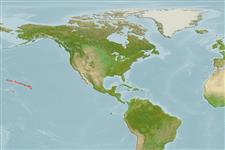>
Anguilliformes (Eels and morays) >
Ophichthidae (Snake eels) > Ophichthinae
Etymology: Myrichthys: Greek, myros, -ou = male of morey eel + Greek, ichthys = fish (Ref. 45335); magnificus: Name means splendid, an adjective..
Environment: milieu / climate zone / depth range / distribution range
Ecología
marino demersal; rango de profundidad 1 - 262 m (Ref. 58302). Tropical
Eastern Central Pacific: Hawaiian Islands, Johnston Island, the Leeward Islands, and Midway Atoll.
Tamaño / Peso / Age
Maturity: Lm ? range ? - ? cm
Max length : 78.0 cm TL macho / no sexado; (Ref. 26145)
Short description
Morfología | Morfometría
Vértebra: 177 - 183. Body moderately elongate, depth 32-45 in TL; yellow to tan with brown to brownish-black spots, variable in size but about equal to or smaller than eye, the spots becoming more numerous in larger specimens. Pectoral fin length less than its base, about 2 in snout (Ref. 40867).
Common in shallow water and occasionally at the surface over sand and coral (Ref. 40867). Benthic in crevices and on sandy or rocky substrata (Ref. 58302).
Life cycle and mating behavior
Madurez | Reproducción | Puesta | Huevos | Fecundidad | Larva
Randall, J.E., 1996. Shore fishes of Hawai'i. Natural World Press, Vida, Oregon. 216 p. (Ref. 26145)
IUCN Red List Status (Ref. 130435)
Threat to humans
Harmless
Human uses
Más información
Nombres comunesSinónimosMetabolismoDespredadoresEcotoxicologíaReproducciónMadurezPuestaAgregación para la puestaFecundidadHuevosEgg development
Age/SizeCrecimientoLength-weightLength-lengthLength-frequenciesMorfometríaMorfologíaLarvaDinámica larvariaReclutamientoAbundanciaBRUVS
ReferenciasAcuiculturaPerfil de acuiculturaRazasGenéticaElectrophoresesheritabilidadEnfermedadesProcesamientoNutrientsMass conversion
ColaboradoresImágenesStamps, Coins Misc.SonidosCiguateraVelocidadTipo de nataciónSuperficie branquialOtolitosCerebrosVisión
Herramientas
Special reports
Download XML
Fuentes de Internet
Estimates based on models
Preferred temperature (Ref.
123201): 5.5 - 15.2, mean 8.7 °C (based on 7 cells).
Phylogenetic diversity index (Ref.
82804): PD
50 = 0.5005 [Uniqueness, from 0.5 = low to 2.0 = high].
Bayesian length-weight: a=0.00089 (0.00039 - 0.00204), b=3.00 (2.80 - 3.20), in cm total length, based on LWR estimates for this (Sub)family-body shape (Ref.
93245).
Nivel trófico (Ref.
69278): 3.5 ±0.4 se; based on size and trophs of closest relatives
Resiliencia (Ref.
120179): Medio, población duplicada en un tiempo mínimo de 1.4-4.4 años (Preliminary K or Fecundity.).
Fishing Vulnerability (Ref.
59153): Moderate to high vulnerability (51 of 100).
